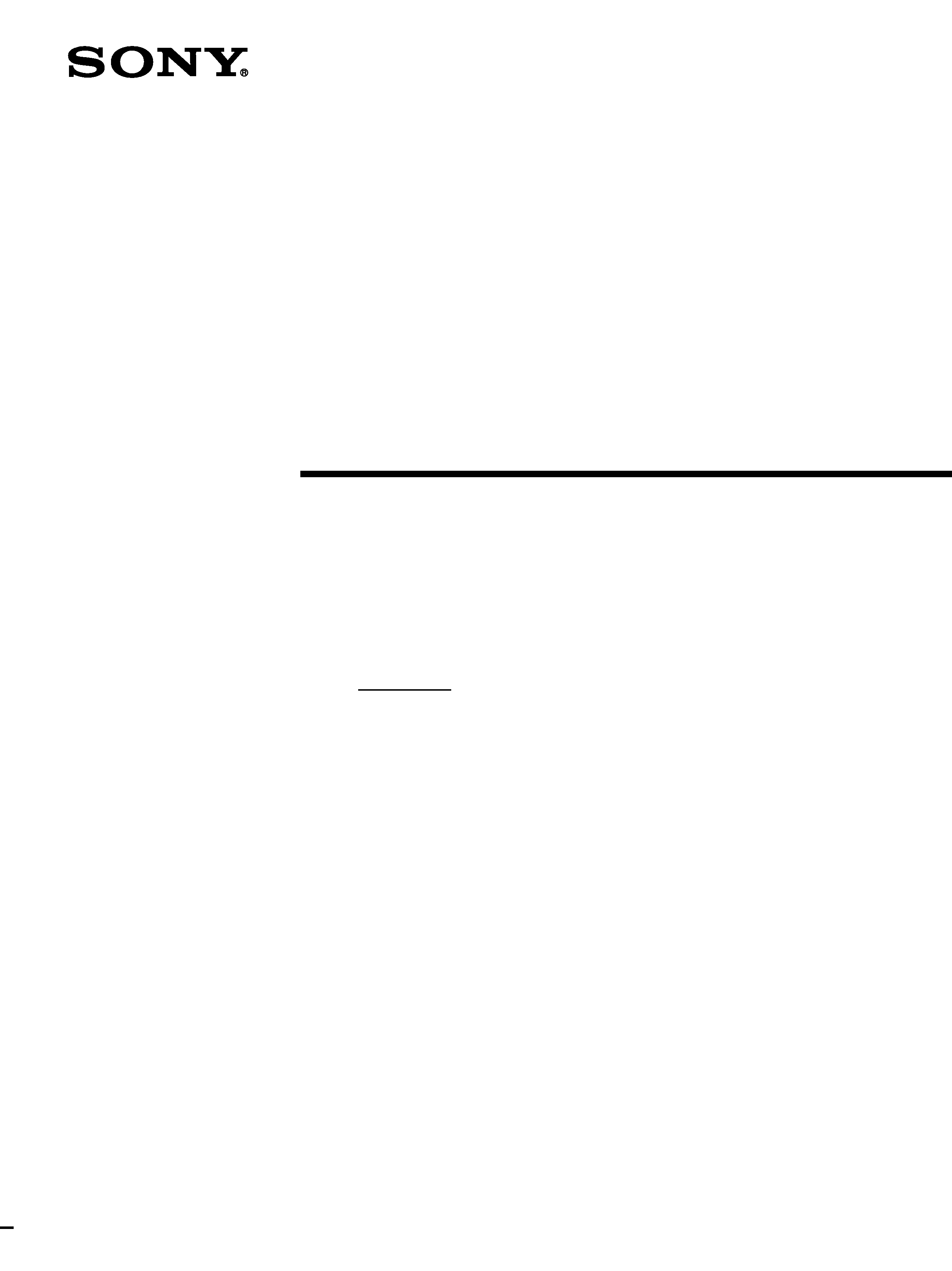
4-233-232-13(4)
Home Theater
System
Operating Instructions
Owner's Record
The model and serial numbers are located on the rear of the unit. Record the serial number in the space
provided below. Refer to them whenever you call upon your Sony dealer regarding this product.
Model No.
HT-DDW830
Serial No.
2001 Sony Corporation
HT-DDW830
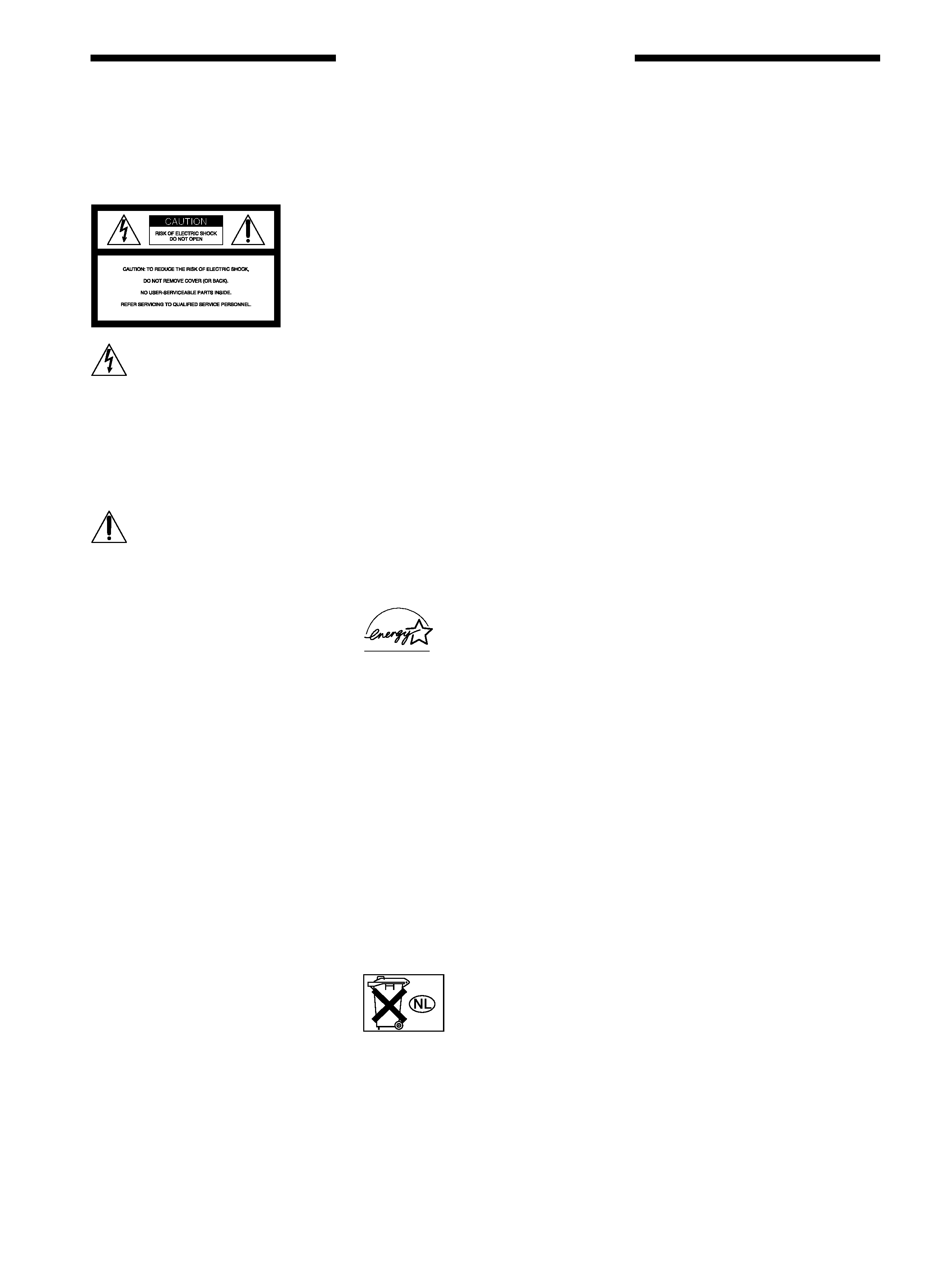
2
WARNING
To prevent fire or shock
hazard, do not expose the
unit to rain or moisture.
This symbol is intended to alert the user to
the presence of uninsulated "dangerous
voltage" within the product's enclosure
that may be of sufficient magnitude to
constitute a risk of electric shock to
persons.
This symbol is intended to alert the user to
the presence of important operating and
maintenance (servicing) instructions in the
literature accompanying the appliance.
INFORMATION
This equipment has been tested and found
to comply with the limits for a Class B
digital device, pursuant to Part 15 of the
FCC Rules.
These limits are designed to provide
reasonable protection against harmful
interference in a residential installation.
This equipment generates, uses, and can
radiate radio frequency energy and, if not
installed and used in accordance with the
instructions, may cause harmful
interference to radio communications.
However, there is no guarantee that
interference will not occur in a particular
installation. If this equipment does cause
harmful interference to radio or television
reception, which can be determined by
turning the equipment off and on, the user
is encouraged to try to correct the
interference by one or more of the
following measures:
Reorient or relocate the receiving
antenna.
Increase the separation between the
equipment and receiver.
Connect the equipment into an outlet on
a circuit different from that to which the
receiver is connected.
Consult the dealer or an experienced
radio/TV technician for help.
CAUTION
You are cautioned that any changes or
modification not expressly approved in
this manual could void your authority to
operate this equipment.
Note to CATV system installer:
This reminder is provided to call CATV
system installer's attention to Article 820-
40 of the NEC that provides guidelines for
proper grounding and, in particular,
specifies that the cable ground shall be
connected to the grounding system of the
building, as close to the point of cable
entry as practical.
For customers in Canada
CAUTION
TO PREVENT ELECTRIC SHOCK, DO
NOT USE THIS POLARIZED AC PLUG
WITH AN EXTENSION CORD,
RECEPTACLE OR OTHER OUTLET
UNLESS THE BLADES CAN BE FULLY
INSERTED TO PREVENT BLADE
EXPOSURE.
For customers in the United States and
Canada
ENERGY STAR® is a U.S.
registered mark.
As an ENERGY STAR® partner,
Sony Corporation has
determined that this product
meets the ENERGY STAR®
guidelines for energy
efficiency.
Precautions
On safety
· Should any solid object or liquid fall into the
cabinet, unplug the receiver and have it
checked by qualified personnel before
operating it any further.
· To prevent fire, do not cover the ventilation
of the receiver with newspapers, table cloths,
curtains, etc. And don't place lighted candles
on the receiver.
· To prevent fire or shock hazards, do not place
vases on the receiver.
On power sources
· Before operating the receiver, check that the
operating voltage is identical with your local
power supply. The operating voltage is
indicated on the nameplate at the rear of the
receiver.
· The unit is not disconnected from the AC
power source (mains) as long as it is
connected to the wall outlet, even if the unit
itself has been turned off.
· If you are not going to use the receiver for a
long time, be sure to disconnect the receiver
from the wall outlet. To disconnect the AC
power cord, grasp the plug itself; never pull
the cord.
· One blade of the plug is wider than the other
for the purpose of safety and will fit into the
wall outlet only one way. If you are unable to
insert the plug fully into the outlet, contact
your dealer. (Models of area code U, CA only)
· AC power cord must be changed only at the
qualified service shop.
On placement
· Place the receiver and speakers in a location
with adequate ventilation to prevent heat
buildup and prolong the life of the receiver
and speakers.
· Do not place the receiver near heat sources,
or in a place subject to direct sunlight,
excessive dust or mechanical shock.
· Do not place anything on top of the cabinet
that might block the ventilation holes and
cause malfunctions.
· Although the receiver heats up during
operation, this is not a malfunction. If you
continuously use this receiver at a large
volume, the cabinet temperature of the top,
side and bottom rises accordingly. To avoid
burning yourself, do not touch the cabinet.
· Do not place the speakers near heat sources
such as radiators or air ducts, or in a place
subject to direct sunlight, excessive dust,
mechanical vibration or shock.
· Do not place the speakers on a soft surface or
in an inclined position, keeping a few
centimeters away from the wall. To abtain a
better bass reproduction, we recommend you
to install the woofer on a solid floor where
the resonance is unlikely to occur.
· If the woofer is installed in the center of a
room, the bass could be extremely weakened.
This is due to the influence of the standing
wave of the room. If this happened, move the
woofer away from the center of a room or
eliminate the cause of the standing wave, by
installing a bookshelf on the wall, etc.
On operation
Before connecting other components, be sure to
turn off and unplug the receiver.
For customers in other countries
To avoid electrical shock,
do not open the cabinet.
Refer servicing to qualified
personnel only.
Do not install the
appliance in a confined
space, such as a bookcase
or built-in cabinet.
Don't throw a battery,
dispose it as the injurious
wastes.
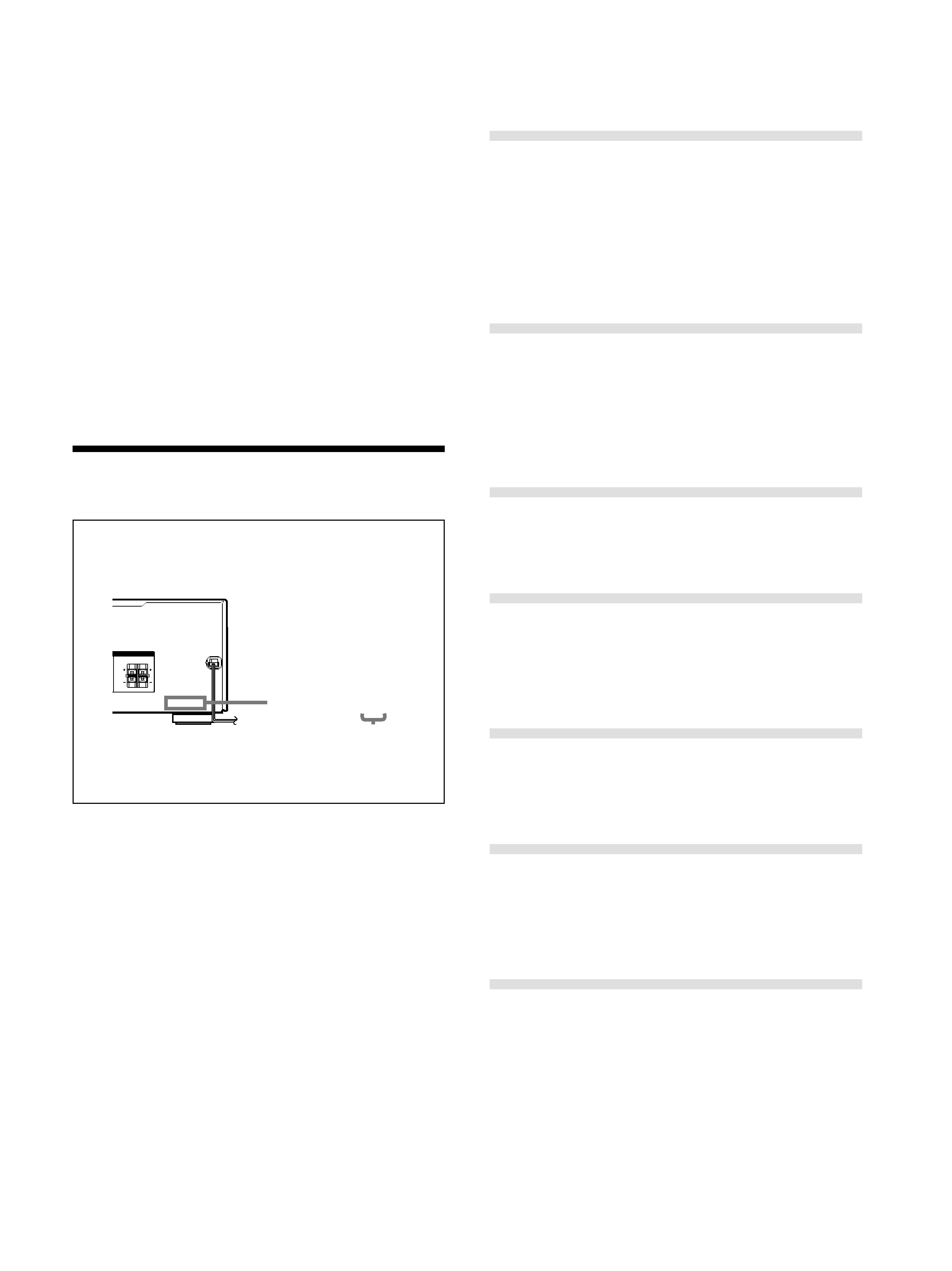
3
If you encounter color irregularity on a nearby TV screen
This speaker system is magnetically shielded to allow it to be
installed near a TV set. However, color irregularities may still be
observed on certain types of TV sets.
If color irregularity is observed...
p Turn off the TV set once, then turn it on again after 15 to 30
minutes.
If color irregularity is observed again...
p Place the speakers further away from the TV set.
If howling occurs
Reposition the speakers or turn down the volume on the receiver.
On cleaning
Clean the cabinet, panel and controls with a soft cloth slightly moistened
with a mild detergent solution. Do not use any type of abrasive pad,
scouring powder or solvent such as alcohol or benzine.
If you have any question or problem concerning your receiver,
please consult your nearest Sony dealer.
About This Manual
About area codes
The area code of the player you purchased is shown on the
lower portion of the rear panel (see the illustration below).
Any differences in operation, according to the area code, are
clearly indicate in the text, for example, "Models of area code
AA only".
Conventions
· The instructions in this manual describe the controls on
the receiver and speakers. You can also use the controls
on the supplied remote if they have the same or similar
names as those on the receiver.
· The following icon is used in this manual:
z
Indicates hints and tips for making the task easier.
This receiver incorporates Dolby
* Digital and Pro Logic
Surround and the DTS** Digital Surround System.
* Manufactured under license from Dolby Laboratories.
"Dolby", "Pro Logic" and the double-D symbol a are trademarks of
Dolby Laboratories.
Confidential unpublished Works. © 1992-1997 Dolby Laboratories.
All rights reserved.
**Manufactured under license from Digital Theater Systems, Inc. US
Pat. No. 5,451,942, 5,956,674, 5,974,380, 5,978,762 and other
world-wide patents issued and pending. "DTS" and "DTS Digital
Surround" are registered trademarks of Digital Theater Systems, Inc.
Copyright 1996, 2000 Digital Theater Systems, Inc. All Rights
Reserved.
FRONT
CENTER
RL
RL
RS
RS
IMPEDANCE USE 8 16
IMPEDANCE USE 8 16
4-XXX-XXX-XX AA
Area code
TABLE OF CONTENTS
Hooking Up the Components
4
Unpacking 4
Antenna Hookups 5
Audio Component Hookups 6
Video Component Hookups 7
Digital Component Hookups 8
MULTI CH IN Hookups 9
Other Hookups 10
Hooking Up and Setting Up the
Speaker System
11
Speaker System Hookup 12
Performing Initial Setup Operations 14
Multi Channel Surround Setup 15
Before You Use Your Receiver 20
Location of Parts and Basic
Operations
21
Front Panel Parts Descriptions 21
Enjoying Surround Sound
25
Selecting a Sound Field 26
Understanding the Multi-Channel Surround
Displays 30
Customizing Sound Fields 32
Receiving Broadcasts
36
Direct Tuning 38
Automatic Tuning 38
Preset Tuning 39
Other Operations
40
Naming Preset Stations and Program Sources 41
Recording 41
Using the Sleep Timer 42
Adjustment Using the SET UP Button 43
Additional Information
44
Troubleshooting 44
Specifications 46
Glossary 49
Settings Using SURR, LEVEL, EQ, and SET UP
buttons 50
Remote Button Description 51
Index 54
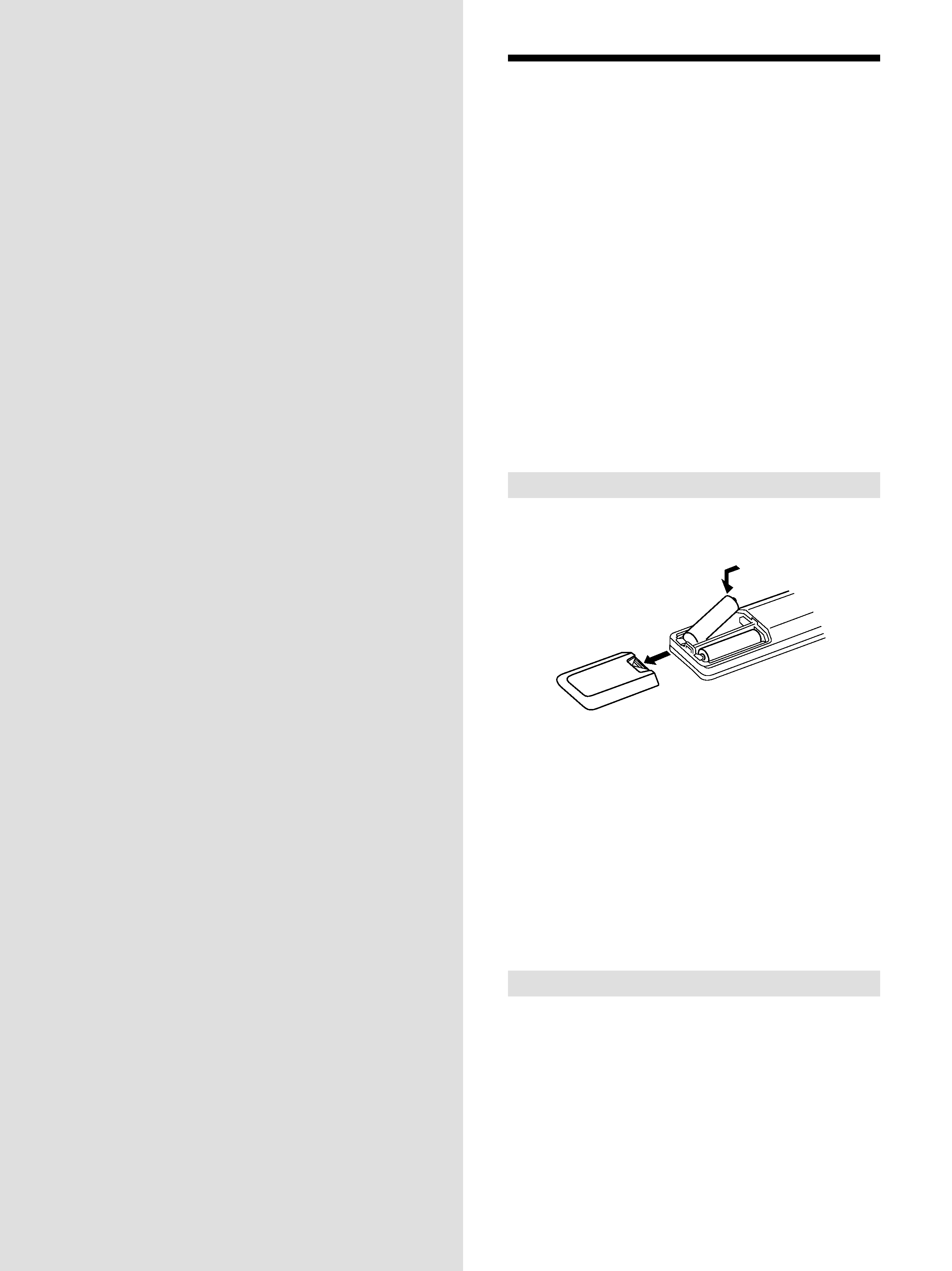
4
Hooking Up
the
Components
This chapter describes how to connect
various audio and video components
to the receiver. Be sure to read the
sections for the components you have
before you actually connect them to
the receiver.
Unpacking
Check that you received the following items with the
receiver:
· FM wire antenna (1)
· AM loop antenna (1)
· R6 (size-AA) batteries (2)
· Remote commander (remote) (1)
· Speakers
· Front speakers (2)
· Rear speakers (2)
· Center speaker (1)
· Subwoofer (1)
· Speaker connecting cord, long (2)
· Speaker connecting cord, short (3)
· Monaural connecting cord (1 phono to 1 phono) (1)
· Coaxial digital cord (1)
· Foot pads (speakers) (20)
· Foot pads (subwoofer) (4)
Inserting batteries into the remote
Insert R6 (size-AA) batteries with the + and properly
oriented in the battery compartment. When using the
remote, point it at the remote sensor g on the receiver.
z When to replace batteries
Under normal conditions, the batteries should last for about 6
months. When the remote no longer operates the receiver, replace
all batteries with new ones.
Notes
· Do not leave the remote in an extremely hot or humid place.
· Do not use a new battery with an old one.
· Do not expose the remote sensor to direct sunlight or lighting
apparatuses. Doing so may cause a malfunction.
· If you don't use the remote for an extended period of time,
remove the batteries to avoid possible damage from battery
leakage and corrosion.
Before you get started
· Turn off the power to all components before making
any connections.
· Do not connect the AC power cords until all of the
connections are completed.
· Be sure to make connections firmly to avoid hum and
noise.
· When connecting an audio/video cord, be sure to
match the color-coded pins to the appropriate jacks on
the components: yellow (video) to yellow; white (left,
audio) to white; and red (right, audio) to red.
]
]
}
}
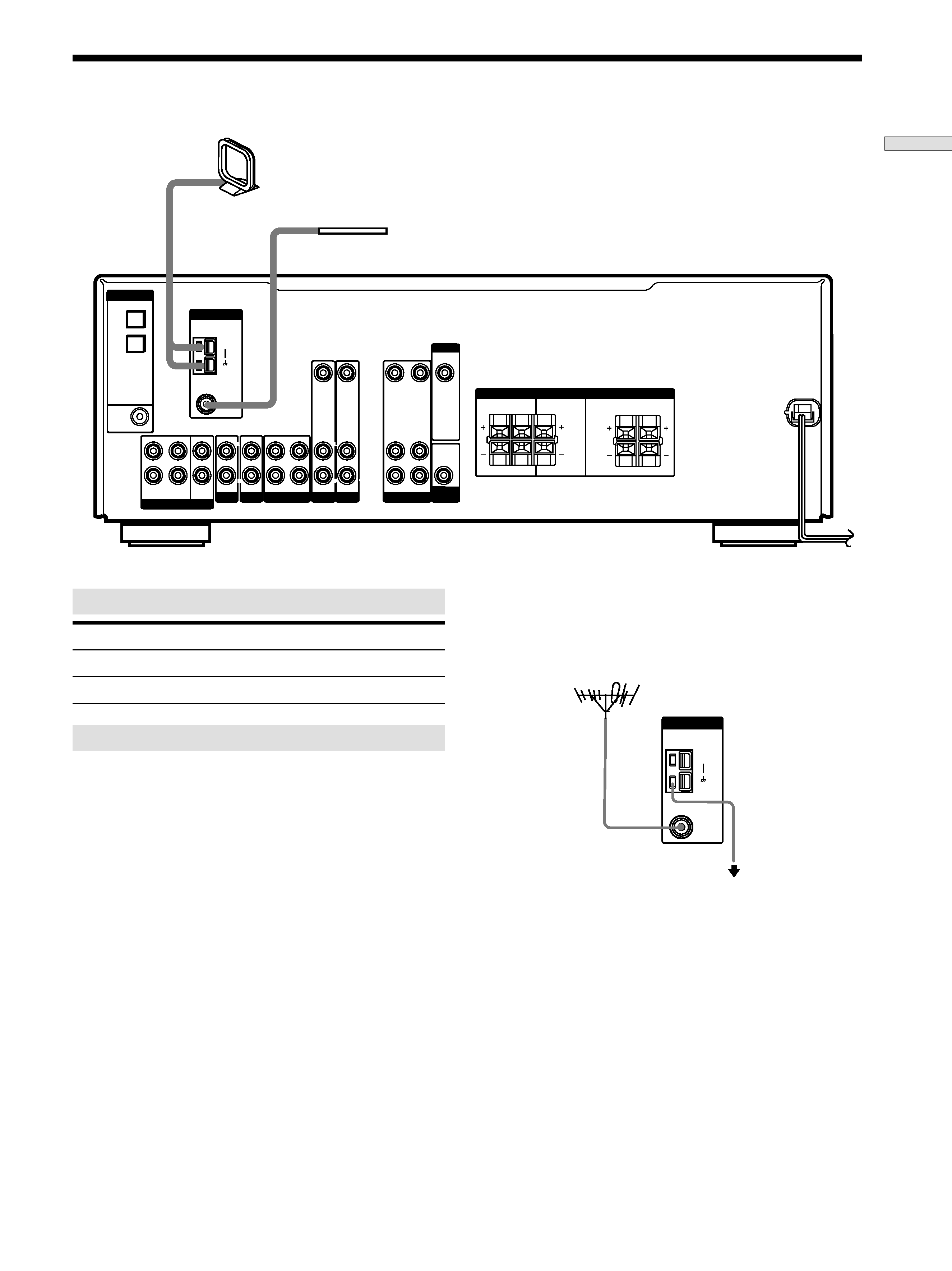
5
Hooking
Up
the
Components
DIGITAL
DVD/LD
IN
COAXIAL
MULTI CH IN
ANTENNA
SUB
WOOFER
MD/TAPE
AUX
CD
TV/SAT DVD/LD
MONITOR
VIDEO
FRONT
CENTER
SURROUND
RL
RL
RL
RL
SPEAKERS
IMPEDANCE USE 8 16
TV/SAT
IN
DVD/LD
IN
OPTICAL
SUB
WOOFER
FRONT
SURROUND
R
L
CENTER
IN
AUDIO IN
AUDIO IN
VIDEO IN
VIDEO IN
VIDEO OUT
VIDEO OUT
VIDEO IN
AUDIO IN
AUDIO OUT
OUT
IN
IN
AUDIO
OUT
AM
R
L
R
L
R
L
R
L
FM
75
COAXIAL
FM wire antenna
(supplied)
AM loop antenna
(supplied)
Terminals for connecting the antennas
Connect the
To the
AM loop antenna
AM terminals
FM wire antenna
FM 75
COAXIAL terminal
Antenna Hookups
ANTENNA
AM
FM
75
COAXIAL
Important
If you connect the receiver to an outdoor antenna, ground
it against lightning. To prevent a gas explosion, do not
connect the ground wire to a gas pipe.
Notes on antenna hookups
· To prevent noise pickup, keep the AM loop antenna
away from the receiver and other components.
· Be sure to fully extend the FM wire antenna.
· After connecting the FM wire antenna, keep it as
horizontal as possible.
Ground wire
(not supplied)
To ground
z If you have poor FM reception
Use a 75-ohm coaxial cable (not supplied) to connect the receiver
to an outdoor FM antenna as shown below.
Outdoor FM antenna
Receiver
